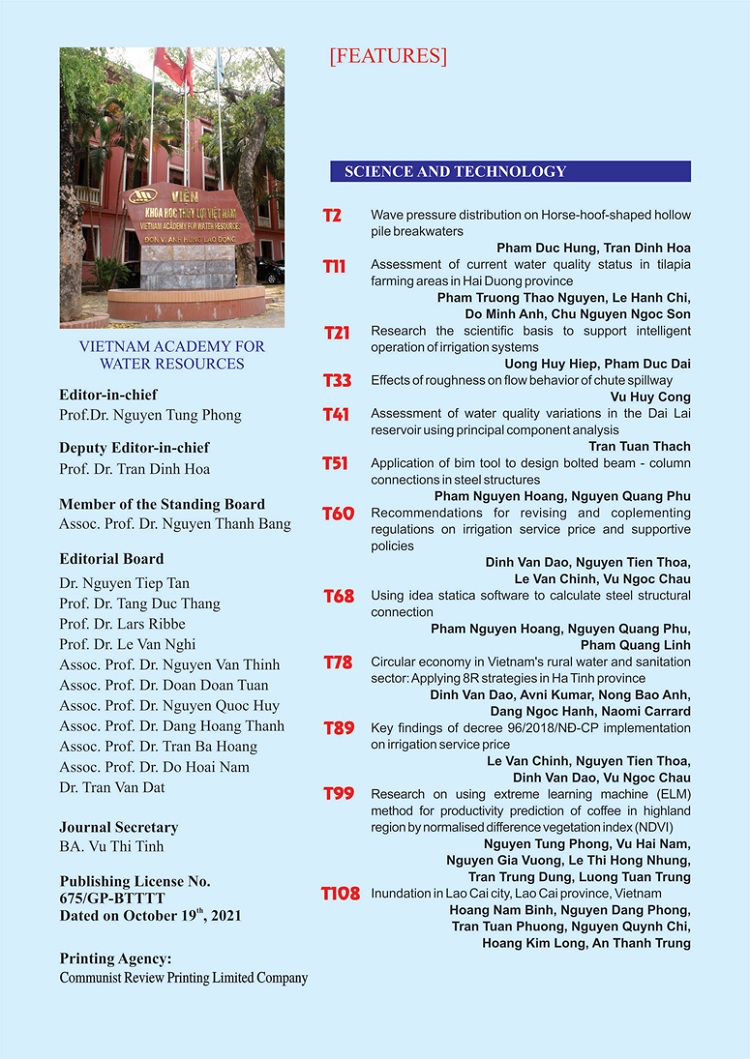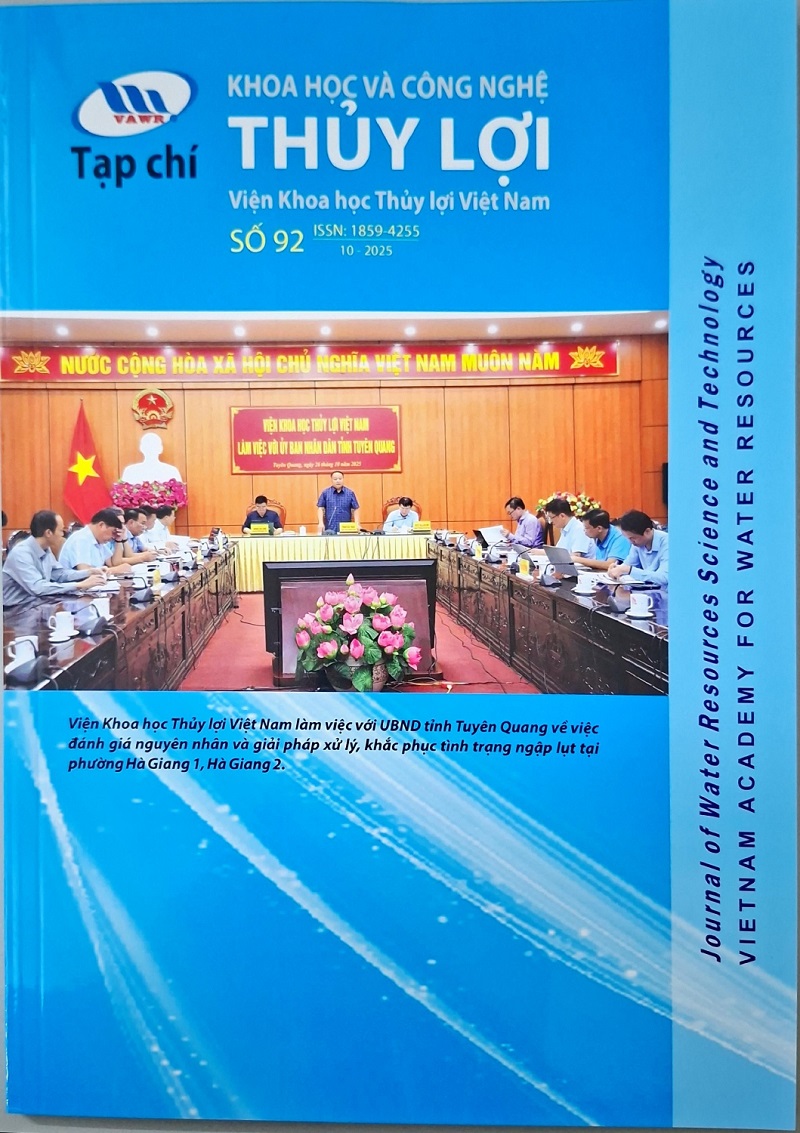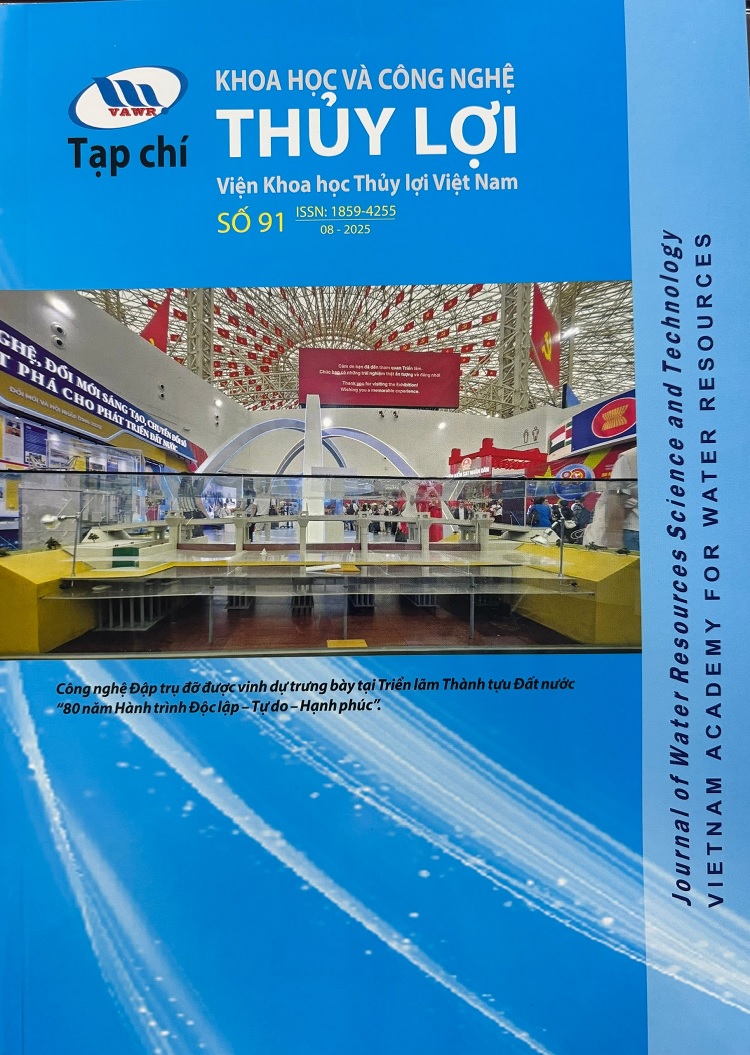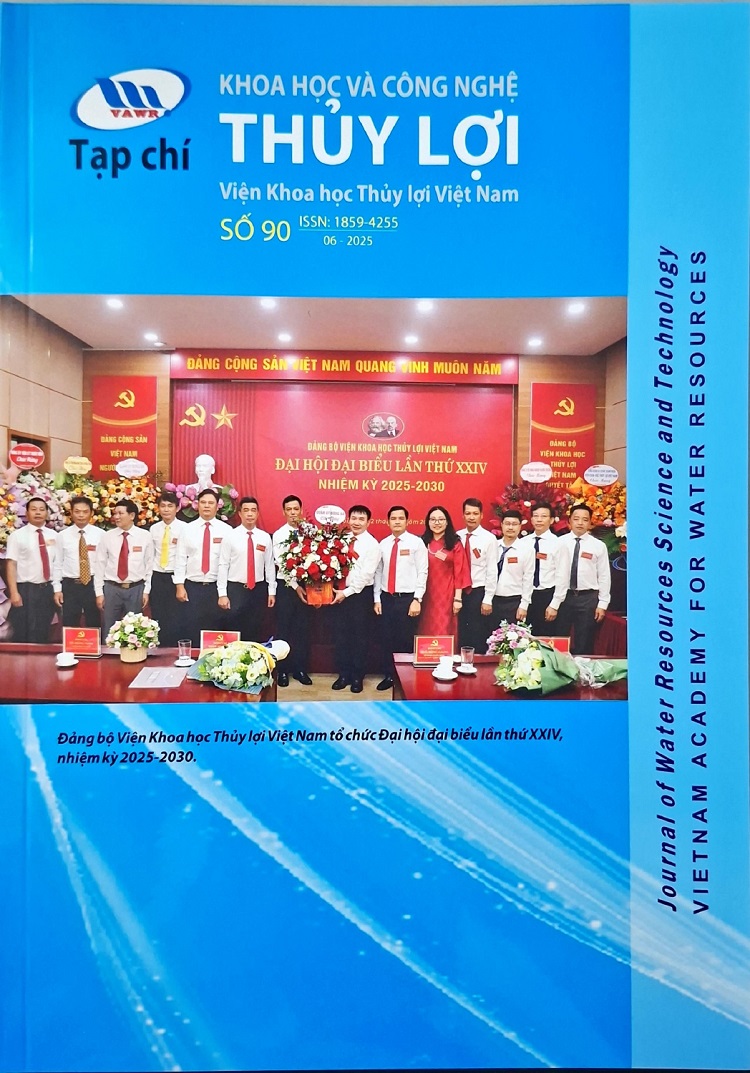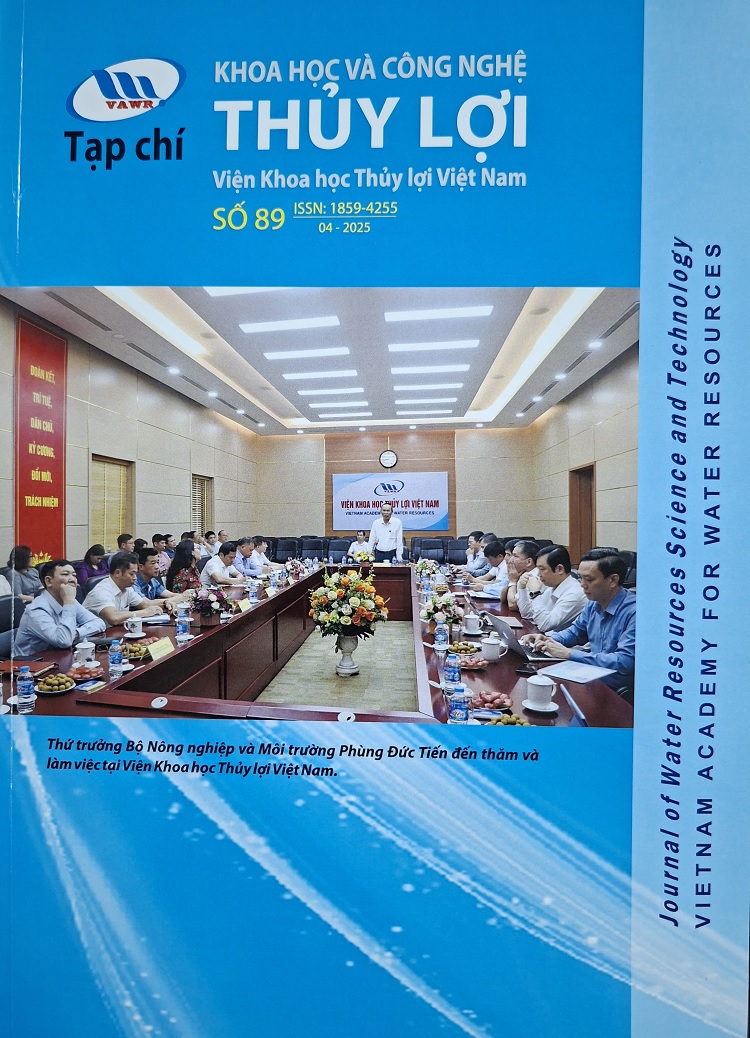Page | Title | Authors | Abstract |
2 | Wave pressure distribution on horse-hoof-shaped hollow pile breakwaters | Pham Duc Hung1, Tran Dinh Hoa1
1. Vietnam Academy for Water Resources | Determining the wave pressure values and creating a distribution chart on breakwaters are critical objectives for assessing the stability of the structure. This paper presents the results of wave pressures and their distribution on Horse-hoof-shaped hollow pile breakwaters (HHPBs) on a physical model. The findings indicate that, with changing wave conditions, water levels, and structural geometric dimensions, the wave pressure distribution diagram acting on the HHPBs in the vertical structure aligns well with the diagram proposed by Goda. Additionally, the wave pressure distribution on the curved surface of the HHPBs is not uniform, with the highest value obtained at the position with the wave direction at an angle of 30 degrees. Keywords: Breakwater, wave pressure, Horse-hoof-shaped hollow pile breakwater. |
11 | Assessment of current water quality status
in tilapia farming areas in Hai Duong province | Pham Truong Thao Nguyen1, Le Hanh Chi1,
Do Minh Anh2, Chu Nguyen Ngoc Son3 1. Institute of Ecology and Works protection, Thuyloi University 1. Institute of Ecology and Works protection 2. Hanoi University of Natural Resources and Environment 3. Vietnam Institute of Meteorology, Hydrology and Climate Chang | This paper presents the results of a water quality assessment in tilapia farming areas at three monitoring points in Thanh Mien district, Hai Duong province. The assessment used several monitoring parameters to evaluate the water quality, including temperature, pH, dissolved oxygen (DO), P-PO43-, N-NO2-, H2S, COD, and coliform. Three methods were employed for the assessment, including the methods of calculating pollutant loads from domestic wastewater, assessing the current state of the water environment based on national standards, and using the water quality index (WQI) assessment. The results indicate that water temperature, pH, DO, and total sulfide in tilapia culture areas were within suitable ranges for tilapia farming. However, 2.86% of samples exceeded permissible limits for N-NH4+ and P-PO43-. In addition, N-NO2-, COD, and coliform density also had sample rates that exceeded the permissible limit, with rates of 48.57%, 40.00%, and 97.14%, respectively. These exceedances adversely affect water quality in the culture area, posing a threat to hygiene and food safety. The WQI index in Hai Duong reached 100%, signifying consistently poor water quality levels observed throughout the monitoring periods. Keywords: Aquaculture, water quality, tilapia, Hai Duong province. |
21 | Research the scientific basis to support intelligent operation of irrigation systems | Uong Huy Hiep1, Pham Duc Dai2 1. Center for Participatory Irrigation Managememt – VietNam Academy for Water Resources 2. Thuyloi University Hanoi, Vietnam | Smart Agriculture holds great importance for countries worldwide, particularly in the face of water scarcity. The efficient utilization of water is crucial across all sectors, with a pressing need in Vietnam. A significant portion of Vietnam's agricultural land relies on irrigation from river branches, where valve gates or pumps are employed to divert water to irrigation channels. Traditional irrigation practices have been based on human experience. However, the current scenario, marked by climate change and complex agricultural activities, has led to fluctuating water levels and flows in rivers, varying rapidly. The reliance on control policies devoid of predictive models has resulted in a lack of reliability, impacting irrigation planning. Furthermore, coordination among the operations of irrigation channel systems in different areas along the same river is essential to ensure an adequate water supply. This paper introduces an innovative approach that utilizes IoT technology and simulation cores to create a computational framework. This framework integrates real-time IoT data with the MIKE 11 model to predict water flows and levels for irrigation channels. The effectiveness of this application is assessed using An Kim Hai river in Vietnam. Keywords: Organizational structure, governance mechanisms, enterprise governance. |
33 | Effects of roughness on flow behavior of chute spillway | Vu Huy Cong1 1. Danang University of Science and Technology- The University of Danang | The surface roughness of the chute spillway is a crucial factor to consider when designing a spillway. In this study, the 3D numerical model ANSYS Fluent is used to study the effect of this factor. The case study is the Tahoet spillway in Lam Dong province. This spillway has a steep channel chute and a stilling basin. The simulated roughness heights are 0.7mm, 1mm, 3mm, and 5mm (corresponding to Manning roughness coefficients n = 0.012–0.017). The effect of roughness on flow behavior is examined based on two variables: velocity and water depth. The velocity decreases as the roughness increases, and the velocity in the vertical direction changes as well. Roughness influences water depth, although to a lesser level. These impacts are more obvious near the end of the chute, where the velocity is large, compared to those at the beginning of the chute, where the velocity is small. The numerical results are compared to experimental results on water depth and velocity, which demonstrate a high degree of consistency. Keywords: Chute spillway, roughness, VOF, Fluent. |
41 | Assessment of water quality variations in the Dai Lai reservoir using principal component analysis | Tran Tuan Thach1 1. Thuy Loi University | Surface water resources play a significant role in Vietnam's economic activities, including artificial freshwater reservoirs, that provide water for agriculture, industry, tourism...etc. Therefore, regular assessment of the reservoir’s water quality has received attention in recent years. In this study, the water quality of Dai Lai Lake - Vinh Phuc province was assessed through monitoring data files from 2019-2023 at locations on the water surface. Results of investigating reservoir water quality based on the WQI composite index show degradation of the aquatic environment and risk of eutrophication in recent years. To thoroughly understand the influencing parameters and causes of pollution, principal component analysis (PCA) was applied to 11 water quality parameters including pH, Electrical conductivity (EC), Dissolved solids (TDS), Suspended solids (TSS), Dissolved Oxygen (DO), Ammonium-nitrogen (NH4-N), Nitrate-nitrogen (NO3-N), Phosphate-Phosphorus (PO4-P), Biochemical oxygen demand (BOD5), Chemical oxygen demand (COD), Coliform bacteria concentration. PCA analysis results show that the first principal component (PC1), including nutrients (NO3-N, NH4-N, and PO4-P) accounts for the total variance at 29,8%, followed by the second principal component (PC2) represents (DO, COD, and BOD5) accounting for 17,54%, the third and fourth principal component (PC3 and PC4) explained about 20% of the total variable and 10% for each PC, representing (TSS, TDS, and EC). From PCA analysis and correlation matrix between factors, it can be seen that the main cause of lake pollution is mainly due to increased nutrients in the lake due to waste from tourism activities and the decomposition of aquatic plants. Keywords: Artificial reservoir, Eutrophication, WQI, Principal component analysis. |
51 | Application of BIM tool to design bolted beam - column connections in steel structures | Pham Nguyen Hoang1,
Nguyen Quang Phu1 1. Thuy Loi University | Building Information Modeling (BIM) is a current trend in the construction industry due to its outstanding advantages. BIM has been applied in all fields, such as design, construction, and building operation… This paper applies the Idea Statica software, as a BIM tool, to design bolted beam - column connections in steel structures. Using the software has made the calculation faster and more intuitive, making it easy for designers to control their connections. At the same time, comparing the results obtained from the software and the results calculated by ordinary mathematics, it can be seen that the Idea Statica software provides high-reliability calculation results, with results having a maximum deviation of 3,5% from the normal calculation through theory. Keywords: BIM, connection, Idea Statica. |
60 | Recommendations for revising and coplementing regulations on irrigation service price
and supportive policies | Dinh Van Dao1, Nguyen Tien Thoa2, Le Van Chinh3, Vu Ngoc Chau4 1. Institute for water resources economics and management 2. Vietnam Valuation Association 3. Thuy Loi University 4. Asian Development Bank | During the reforming process of irrigation management from fee-based to price-based mechanism, detail regulations on irrigation service price and subsidy policies in Decree No. 96/2018/ND-CP (decree 96) contributed as key innovation on changing awareness of irrigation management toward to market orientation. To align with Law on Price 2023 and Law on Hydraulic Work, the decree 96 needs to be modified. Thus, through the assessment of decree application by field survey and policy dialogue conferences, this study indicated some recommendations on revision and complementation of irrigation service price (ISP) calculation principles and basis; regulations of ISP calculation options by cost reflective and comparison methods toward full cost recovery; changing the policies and roadmaps regulations on ISP assistance and supports, ISP collection according to specific subjects in irrigation service use. These provide evidences for policy implication to revise the decree more applicability and appropriate with real conditions and consistent with legal regulations for sustainable irrigation management and agricultural diversification, climate resilience. Keyword: Irrigation service, price, fee, policy, subsidy. |
68 | Using idea statica software to calculate steel structural connection | Pham Nguyen Hoang1, Nguyen Quang Phu1, Pham Quang Linh1 1. Thuy Loi University | In steel structures, to obtain a complete load-bearing structure, individual components are assembled together through connections. Connections play an important role in the performance of steel structures. There are two main types of connections in steel structures: welded connections and bolted connections. The connection design in steel structures is an important and complex problem. Consequently, the research on some connections in steel structures has scientific and practical significance. In this paper, the research scope will be limited to bolted connections subjected to shear force and bolted connections subjected to moment. Keywords: Steel structure, connection, Idea Statica. |
78 | Circular economy in vietnam’s rural water
and sanitation sector: applying 8R strategies
in Ha Tinh province | Dinh Van Dao1, Avni Kumar2, Nong Bao Anh2, Dang Ngoc Hanh1 and Naomi Carrard2 1. Institute for Water Resources Economics and Management 2. University of Technology of Sydney | The concept of a circular economy, although relatively new, has long been implemented in rural areas of Vietnam, yielding positive environmental impacts and facilitating resource efficiency, as exemplified by the VAC model. But for the rural water supply and sanitation, how to move from linear concepts to operationalising circular practices which can drive safely managed, inclusive, climate resilient services require more attention. In an effort to address this challenge, an international collaboration between researchers from the University of Technology Sydney and the Institute for Water Resources Economics and Management has resulted in the development of a framework known as the 8R strategies framework, aimed at integrating circular economy principles into water and sanitation systems. This framework was tested in the Ha Tinh provinces as part of a project case study. Research so far revealed significant potential for the application of circular economy principles across technical and economic domains, offering numerous benefits for policy directions in water and sanitation management, climate resilience, and sustainable development. Keywords: Circular economy, water, sanitation, waste, rural. |
89 | Key findings of decree 96/2018/NĐ-CP implementation
on irrigation service price | Le Van Chinh1, Nguyen Tien Thoa2, Dinh Van Dao3, Vu Ngoc Chau4 1. Thuy Loi University 2. Vietnam Valuation Association 3. Institute for water resources economics and management 4. Asian Development Bank | Since 2018, Vietnam has transitioned to implementing water services pricing policies as stipulated by the Law on Hydraulic Works and specifically detailed in Government Decree 96/2018/NĐ-CP. This is a sound and breakthrough policy in irrigation management aimed at enhancing the efficiency of irrigation works for production and livelihoods. While some progress has been made in implementing this policy, there are still numerous limitations and challenges that need to be addressed. To propose solutions for amending and adjusting policies in Decree 96, this study focuses on assessing the impacts and outcomes of implementing the decree, as well as identifying key remaining limitations which could be used for proposing recommendations of revision and complementation of the irrigation service policies. In addition to utilizing secondary documents, the study conducts surveys and evaluations of the decree's implementation in seven provinces in various regions with different types of irrigation systems. Keywords: Irrigation service price, irrigation management, subsidy, cost estimation. |
99 | Research on using extreme learning machine (ELM) method for productivity prediction of coffee in highland region by normalised difference
vegetation index (NDVI) | Nguyen Tung Phong1, Vu Hai Nam2, Nguyen Gia Vuong2,
Le Thi Hong Nhung2, Tran Trung Dung2, Luong Tuan Trung3 1. Department of Water Resources Ministry of Agriculture and Rural Development 2. Vietnam Academy for Water Resources 3.Vietnam Institute of Meteorology, Hydrology and Climate Change | Vietnam is the leading coffee exporter in the world with 1.78 million tons, reaching an export value of more than 4 billion USD in 2022 [2]. The Central Highlands region is the largest coffee cultivation area in Vietnam with an area of 639.3 thousand hectares, accounting for over 90% coffee area of whole country. Remote sensing technology has been used in research on forecasting coffee yield by satellite-derived actual evapotranspiration as well as in separating cultivated areas and forecasting rice and dragon fruit trees yields by normalized difference vegetation index (NDVI) in Vietnam [5]. This paper presents the results of research on using the extreme learning machine (ELM) method to find the relationship between coffee yield and NDVI index from remote sensing images of the Sentinel-2 satellite at the different growth phases of coffee tree in the study site. Prediction error of coffee yield by NDVI ranged 6.27% to 12.33% at pre-flowering phase, from 5.10% to 6.64% at flowering phase and from 3.14% to 5.29% at fruit producing phase. The study result is the basis for separating, interpreting cultivated areas and predicting yield of coffee tree in the Central Highlands region through remote sensing images and ELM methods. Thereby helping farmers have plans to deal with negative impacts on production efficiency as well as help governments and policy makers to offering early warning of potential risks in coffee cultivation. Keywords: NVDI, ELM, remote sensing, images, Sentinel, Landsat, coffee, predicted yield. |
108 | Inundation in Lao Cai city, Lao Cai province, Vietnam | Hoang Nam Binh1, Nguyen Dang Phong1
Tran Tuan Phuong2, Nguyen Quynh Chi2
Hoang Kim Long3, An Thanh Trung3 1. Faculty of Civil engineering, University of Transport and Communications
2. Student, Faculty of International education,
University of Transport and Communications 3. Lao Cai Transport construction consultancy joint stock company | Lao Cai city, Lao Cai province, is located in the northern border area between the Northeast and Northwest regions of Vietnam. The rainy season is from April to October, with 70-80% of the annual rainfall. In this time, Lao Cai city was often inundated after heavy rains. The depth of the flood is about 0.5 - 0.8m. There are some places where the depth is nearly 2m to more than 2m, such as Le Thanh Street, Bac Cuong ward. This article presents the current drainage system and proposes solutions to increase the drainage capacity for Le Thanh street, Bac Cuong ward, Lao Cai city, Lao Cai province, Vietnam. Keywords: Lao Cai city inundated, Urban flood, Hydraulic culvert, Rainwater drainage. |


